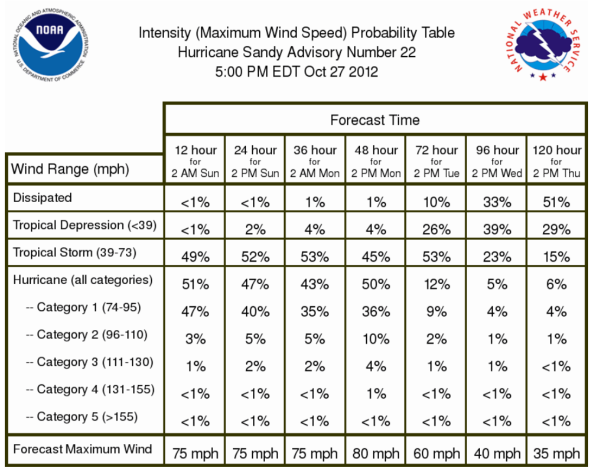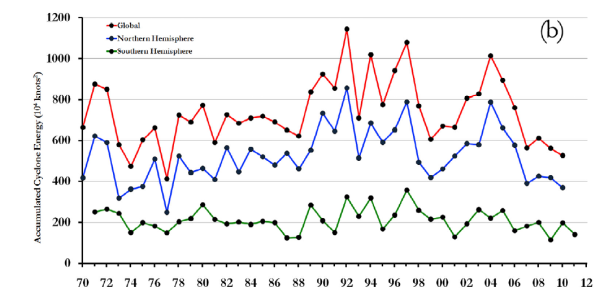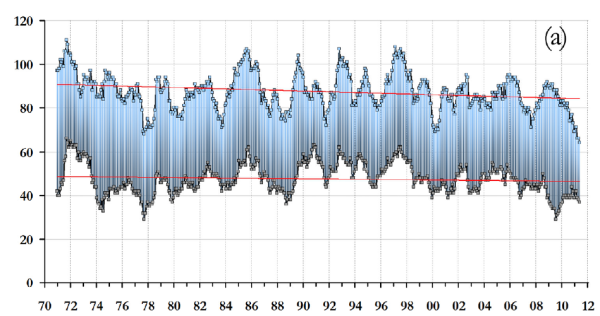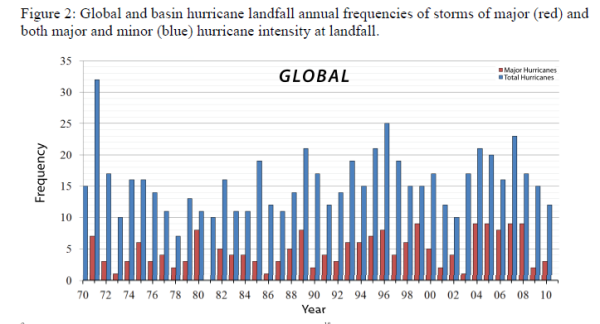Summary: When did normal weather become exceptional? Hurricane Sandy tells us much about our climate, weather ? and ourselves. The truth is out there, if only we wished to see it. If you find this useful, please pass it on to others!

Nothing ?historic? in these numbers.
Contents
- Hysteria about Hurricane Sandy
- The problem with hurricanes is us
- Are they becoming more frequent, more extreme?
- What if Sandy hit New York City?? NYC?s history tells the tale (plus more info about hurricanes)
- For More Information about Sandy, hurricanes, and us
(1)? Two of the many instances of hysteria about Hurricane Sandy
(a) AP, 27 October 2012 (for comparison, see section 4 for details about the 1893 hurricane that hit NYC):
?New York City began precautions for an ominous but still uncertain forecast. ? Jeff Masters, meteorology director of the forecasting service Weather Underground, said this could be as big, perhaps bigger, than the worst East Coast storm on record, a 1938 New England hurricane that is sometimes known as the Long Island Express, which killed nearly 800 people.
(b) ?Northeast in crosshairs of possible ?superstorm? Sandy?, CNN, 27 October 2012 ? My favorite Sandy-hysteria (we don?t have East coast storm data for 500 years, back to Columbus):
Computer models predict Delaware, Maryland and Virginia could see up to a foot of rain, according to the CNN Weather Unit. Isolated spots could see the worst rains in 500 years.
? Sandy presents a scenario not unlike the one that led to 1991?s ?Perfect Storm,? when moisture flung north by Hurricane Grace combined with a high pressure system and a cold front to produce a tempest in the north Atlantic over Halloween. But Grace never made landfall.
(2)? The problem with hurricanes is us
.
Sandy could have severe effects, as described by the forecasts of the National Weather Service?s Public Advisory and forecast of their Hydrometeorological Prediction Center.
Some sound news: ?5 reasons why Sandy is expected to be a superstorm?, AP, 27 October 2012:
- Northbound hurricane
- Early winter storm
- Arctic air from the North
- High tides could worsen flooding
- Combo of snow, wind increases risk for widespread power outages
None of these factors is ?historic? or even unusual by themselves (see this WaPo article for more technical details).? The combination is unusual, but certain to happen repeatedly over time.
The AP ? and most news stories about Sandy ? do not mention the key factor that might cause large property losses: during the past 0 years we?ve built massive urban complexes with inadequate attention to normal weather effects.? Some of this development is mad ? such as construction in floodplains and barrier islands (much of which occurs only due to the subsidies of the Federal Flood Insurance program and disaster relief programs).? New Orleans ? near the ocean, in a major storm area, and below sea level.
The result is increasing property damage and disruption of vital infrastructure ? although less loss of life, as our infrastructure improves in quality and resilience.
The news media reflect the structure of our society.? Their biases combine to happy commercial effect:? chronic disasterphilia, love of the ?extreme climate? narrative, and reluctance to blame our corporate rulers.
The missing words from almost every news story: ?this during this current period of record low global hurricane activity?.? See the next section for details.
(3)? Are hurricanes becoming more frequent, more extreme?
We?re in a period of low activity, although you?d not learn that from the US news media.
(a) ?Recent historically low global tropical cyclone activity?, Ryan N. Maue, Geophysical Research Letters, 20 July 2011 ? Conclusion (references omitted; red emphasis added):
It is still a fundamental research question as to what are the atmosphere and ocean mechanisms responsible for the observed annual global TC frequency of ?87 storms. With the upcoming IPCC AR5 assessment and associated CMIP5 climate simulations, it is critical to have the best possible diagnosis of periods of global TC inactivity and incorporate the recent pentad of historical lows into the context of natural and anthropogenically forced climate variability. Furthermore, research must better explain the role of tropical cyclones in the climate system especially during this current period of record inactivity.
Global tropical cyclone Accumulated Cyclone Energy (ACE units 104 knots2), annual totals from 1970?2011.

Global tropical cyclone frequency, monthly from 1970?2011: 12?month running sums including all TCs (top time series), and only hurricane force TCs (bottom time series).

(b)? ?Historical global tropical cyclone landfalls?, Jessica Weinkle, Ryan Maue and Roger Pielke Jr, Journal of Climate, in press ? Conclusion (references omitted):
From currently available historical tropical cyclone (TC) records, we constructed a long-period global hurricane landfall dataset using a consistent methodology. We have identified considerable interannual variability in the frequency of global hurricane landfalls, but within the resolution of the available data, our evidence does not support the presence of significant long-period global or individual basin linear trends for minor, major, or total hurricanes within the period(s) covered by the available quality data. Therefore, our long-period analysis does not support claims that increasing TC landfall frequency or landfall intensity has contributed to concomitantly increasing economic losses. Due to documented multidecadal variations in TC frequency and intensity on global and basin scales, our findings strongly support the usage of long-period historical landfall datasets for trend analysis.
While there is continued uncertainty surrounding future changes in climate, current projections of TC frequency or intensity change may not yield an anthropogenic signal in economic loss data for many decades or even centuries. Thus, our quantitative analysis of global hurricane landfalls is consistent with previous research focused on normalized losses associated with hurricanes that have found no trends once data is properly adjusted for societal factors.

Weinkle, J., R. N. Maue, R. Pielke Jr. (2012)
(4)? What if Sandy hits NYC, plus more info about hurricanes
Despite the hysteria about Sandy being ?the worst?, there have been many horrific hurricanes in US history.? Fortunately most when our population density was lower, our cities far smaller.
(a)? Sandy might resemble Hurricane Hazel of 1954. See the NWS history page; and their detailed description here. Hat tip on this to Brad Johnson at WUWT.
(b)? Sandy might hit New York City. Its history shows us what to look forward to ?
The short, light version:? ?16 Unsettling Facts About New York City And Hurricanes?, BuzzFeed, 25 October 2012
The details are in this excerpt from ?Storm Tracker?, New York Magazine, 4 September 2005 ? ?A history of hurricanes in New York ? including the day in 1893 that Hog Island disappeared for good.?
But our own hurricane history is more tumultuous than many New Yorkers might think. In 1821, when a major hurricane made a direct hit on Manhattan, stunned residents recorded sea levels rising as fast as thirteen feet in a single hour down where there?s now Battery Park City. Everything was flooded south of Canal Street. The storm struck at low tide, though, and, according to Queens College professor Nicholas Coch, a coastal geologist who calls himself a ?forensic hurricanologist,? that?s ?the only thing that saved the city.?
Then there?s Hog Island. The pig-shaped mile-long barrier island was off the southern coast of the Rockaways. After the Civil War, developers built saloons and bathhouses on it, and Hog Island became a Gilded Age version of the Hamptons. The city?s political bosses and business elite used the place as a kind of beachy annex of Tammany Hall. That all ended on the night of August 23, 1893, when a terrifying Category 2 hurricane made landfall on the swamp that is now JFK airport.
The hurricane was a major event. All six front-page columns of the August 25, 1893, New York Times were dedicated to the ?unexampled fury? of the ?West Indian monster.? The storm sunk dozens of boats and killed scores of sailors. In Central Park, hundreds of trees were uprooted, ? a 30-foot storm surge swept across southern Brooklyn and Queens, destroying virtually every man-made structure in its path.
As for Hog Island, ?it largely disappeared that night,? Coch says. ?As far as I know, it is the only incidence of the removal of an entire island by a hurricane.?
Statistically, the New York area is hit by one of these monster storms every 75 years or so; ?it?s just a matter of time,? says Lee. After Hog Island, the next big one came a little ahead of schedule, the ?Long Island Express? of 1938, with 183-mile-per-hour winds. At the time, Long Island wasn?t a densely populated suburban sprawl. The same hurricane today would cause incredible havoc. Hurricane Carol, a Category 3 storm that hit eastern Long Island and came ashore in Connecticut in 1954, mostly missed the city (even as it inundated downtown Providence, Rhode Island, under twelve feet of water).
Were another Long Island Express to barrel in, AIR Worldwide Corporation, an insurance-industry analyst, estimates $11.6 billion in New York losses alone. On AIR?s list of ?the top ten worst places for an extreme hurricane to strike,? New York City is No. 2, behind only Miami. New Orleans is ranked fifth.
(c)? The history of hurricanes hitting the US:
- NWS page on Hurricanes in History (1900-now) ? Some of these were really big, and would cause massive destruction today
- ?Hurricane Sandy: A history of big storms in New Jersey?, AP, 26 October 2012
- Everything you could want to know about ?The Deadliest, Costliest, and Most Intense United States Tropical Cyclones?,? Eric S. Blake, Christopher W. Landsea, and Ethan J. Gibney, NOAA, August 2011
(5)? FM posts about climate change
- How warm is the Earth? How do we measure?it?, 28 January 2009
- Aerosols (pollutants, like soot) as a driver of climate?change, 8 May 2009
- Might the current eruptions in Iceland become worse, affecting Europe ? and perhaps our?climate?, 19 May 2010
- About the increasing number of?hurricanes, 31 May 2010
- Death?of?the?seas?from?CO2?acidification, 4 September 2010
- How good are our global senses, watching?our?changing?world?, 15 October 2010
- Looking into the past for guidance about warnings of future?climate?apocalypses, 17 October 2010
- Watching decadal swings in global climate (pretending to be anthropogenic global warming), 17 March 2011
- What we know about our past climate, and its causes, 2 February 2012
- Still good news: global temperatures remain stable, at least for now., 14 October 2012
- When did we start global warming? See the surprising answer (it?s not what you?ve been told)., 18 October 2012
.
Like this:
Be the first to like this.
Source: http://fabiusmaximus.com/2012/10/28/weather-hurrican-sandy-44675/
red dawn california earthquake california earthquake tyson chandler tyson chandler stephen hill draft tracker
কোন মন্তব্য নেই:
একটি মন্তব্য পোস্ট করুন